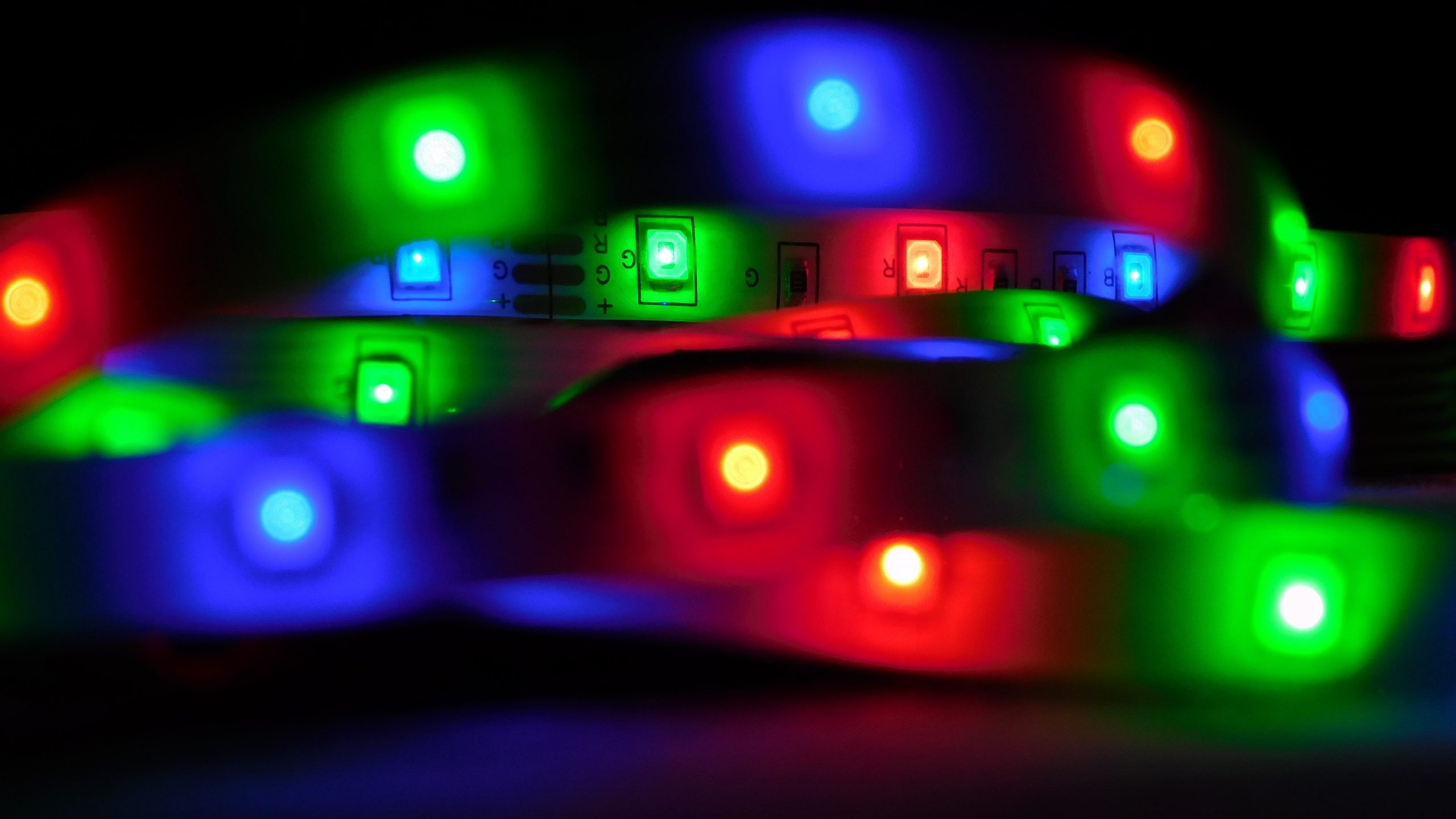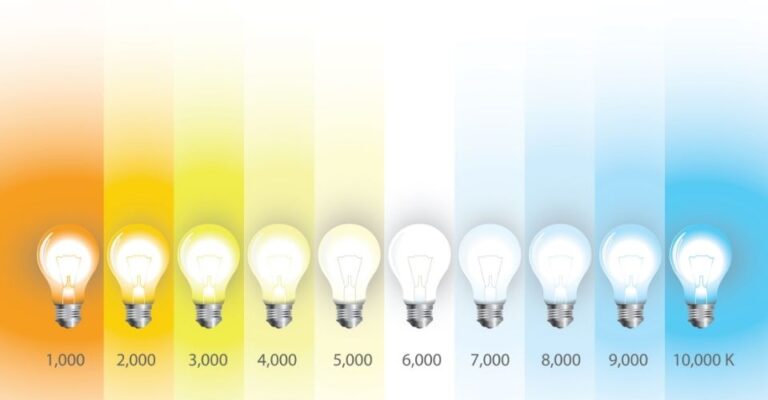Color rendering index (CRI)
A numerical value that tells the difference between how objects appear under a light source compared to how they would look under natural sunlight at noon on a clear day (with 100 CRI). Lighting with a CRI greater than 80 is recommended for general purposes, while lighting with a CRI greater than 90 is recommended for environments where color accuracy may be important, such as in museums and design studios.
A spectrum of light sources
The spectrum of a light source shows the distribution of colors within the given light source. The shape also has an effect on how easy it is to see certain objects under the light source and how the objects appear when they are lit up by this type of light.
Add More Color To Your Space With LED Strips
Shapes of LED lights
The most common shapes that LED lights come in are sphere (or globe), strip (linear), and panel (also called flat-top or plane). Other shapes include PAR38, MR16, cylindrical tubes, annular rings, and more. Colors can vary depending on the shape of the LED. For example, blue LEDs are typically found in strip form and emit a bright blue light.
There are many different types of LED lights that are available on the market today. Some of the most common types include white light LEDs, blue light LEDs, red light LEDs, green light LEDs, and multi-color LEDs. Each type of LED has its own unique set of characteristics that sets it apart from the others.
One important characteristic to consider when choosing an LED is the color rendering index (CRI). This value tells you how accurate the colors of objects appear under a particular LED light source compared to how they would look under natural sunlight. Lighting with a CRI greater than 80 is generally recommended for general

What do the different colors of LED lights mean?
The different colors of LED lights each have their own specific meaning. Here is a breakdown of what they mean.
White LED light color meaning
As previously mentioned, white light LEDs are the most common type of light source and can be used for many different purposes. They emit a bright white light that is perfect for general use. It is great for your workplace or study.
Blue LED light color meaning
Blue LEDs are often used in medical applications as they have been shown to have positive effects on the human body. They are also found in some backlit keyboards.
Red LED light color meaning
Red LEDs are used in many scientific applications, as well as sporting and aviation applications. They emit a bright red light that is easily visible for human vision. Green yellow and orange lights also fall into this category with green being more highly recommended than yellow or orange due to how easy it is to see under this color range.
Multi-color LED light color meaning
Multi-color LEDs are the most versatile type of LED and can be used for a variety of applications. They emit a range of colors that can be changed depending on the needs of the user. This type of LED is perfect for tasks that require different colors, such as in art and design studios.
The choice depends on whether you want ambient lights for the atmosphere or a good source of light for reading.
LED light color meaning: Color temperature differences
The color temperature of a light source is the measure of the "warmth" or "coolness" of the light. It is measured in degrees Kelvin (K). A higher color temperature means that the light is cooler in color, while a lower color temperature means that the light is warmer in color.
Warmer light is used for tasks that require a relaxed atmosphere, such as reading and relaxing. Cooler light is used for tasks that require focus and concentration.
Cooler LED light is used in office settings
The color temperature of LED lights can vary depending on the type of LED. White light LEDs typically have a color temperature range of 3,000K to 6,500K.
Blue light LEDs have a color temperature range of 10,000K to 20,000K. Red light LEDs have a color temperature range of 2,000K to 3,000K. Green light LEDs have a color temperature range of 5,000 to 7,500K. Multi-color LEDs have a color temperature range that varies depending on the colors that are being emitted.

How do LEDs change the color temperature?
The color temperature of LEDs can be changed in two ways. The first is by adding a phosphor coating to the LED that converts some of the light into another wavelength. This process alone may not be enough to change the color temperature, however, so it is common for manufacturers to use different materials when creating the LED package.
For example, blue LEDs are often constructed using gallium nitride instead of gallium arsenide because it allows them to emit more light at longer wavelengths, which makes it easier to adjust their color temperature.
How do RGB LEDs work?
RGB LEDs are made up of red, green, and blue diodes. These three diodes are combined together in a way that makes it difficult for the human eye to differentiate between the individual colors. This allows for a wide range of colors to be produced.
RGB LEDs are controlled by a microcontroller. This is a small computer that is used to control the flow of current through the LED. By changing the amount of current that flows through the LED, you can change the wavelength of light that is being emitted.
The microcontroller can be programmed to generate any color that you want. It can also be programmed to create different patterns and animations. This allows for a wide range of customization for your lighting needs.
RGB LEDs are commonly used in televisions, video games, and other electronic devices. They are also becoming more popular in residential and commercial applications.
What is the difference between RGB and RGBW?
RGBW LEDs are made up of red, green, blue, and white diodes. This allows for a wider range of colors to be produced than with RGB LEDs. It also allows for better color accuracy as the white diode helps to correct any errors that might occur with the other three diodes.
The white diode also helps to increase the brightness of the light. This is because it can act as a kind of reflector, directing more light towards the viewer. This makes RGBW LEDs ideal for use in applications where high brightness is desired.
RGBW LEDs are becoming more popular in residential and commercial applications. They are often used in places where high-quality color accuracy is important, such as in TV studios and advertising displays.
Multicolor LEDs changing color
How can LEDs generate up to 16 million colors?
White light LEDs are different from other types of LEDs in that they contain a mix of red, blue, and green lights. This allows them to create the full-color spectrum with ease. These 3 diodes are combined together in a way that makes it difficult for the human eye to differentiate between the individual colors.
LEDs are capable of producing a wide range of colors because they can be tuned to specific wavelengths. This is done by controlling the amount of current that flows through the LED. By changing the current, you can change the wavelength of light that is being emitted.
Different colors of light have different wavelengths.

Full-spectrum lighting is a type of LED light that emits a full spectrum of colors from ultraviolet to infrared. This allows for an extremely large amount of heat dissipation and neutralizes the need for multiple types of lights.
Ultraviolet light is not visible to the human eye, but it has a number of important applications. It is used in medical and scientific applications, as well as in tanning beds. Infrared light is also not visible to the human eye, but it is used for night vision and thermal imaging.
Other colors (not just red, blue, and green) appear when the level of current is adjusted to the LED. When an LED is not producing white light, it will produce one of the other colors that are available. This happens when the level of current is adjusted to the LED. By doing this, you can create any color that you want by controlling the amount of current that flows through the LED. This is a great way to customize your lighting needs.
You can also mix different LED colors together to create new colors and moods. Some light colors are used as a supplement for the therapeutical effect. It is called chromotherapy or color therapy and it is based on colors' influence on our mental state.
Is it possible to change a white bulb to RGB?
It is possible to change a white bulb to RGB, but it requires a special adapter. This adapter allows you to control the flow of current through the LED. By doing this, you can change the wavelength of light that is being emitted.
RGB LEDs are controlled by a microcontroller. This is a small computer that is used to control the flow of current through the LED. By changing the amount of current that flows through the LED, you can change the wavelength of light that is being emitted.
The microcontroller can be programmed to generate any color that you want. It can also be programmed to create different patterns and animations. This allows for a wide range of customization for your lighting needs.
Can LEDs damage the eyes?
LEDs do not emit UV or IR radiation which is what causes sunburns. However, they can emit blue light at high levels which can cause discomfort to your eyes. You can reduce this discomfort by wearing sunglasses when you are in front of a display with an LED screen (such as a TV). Some TVs will include special settings to reduce discomfort if you find it bothersome.
The human eye has three types of color receptors called cones. These each respond differently to different colors of light depending on their wavelengths (this is how our brain knows what color we are seeing). The blue light that is emitted by LEDs can cause the cones in your eye to become over-stimulated. This can lead to discomfort, fatigue, and even headaches.
Reducing blue light exposure is especially important for people who work with LED screens all day. You can reduce blue light exposure by using a blue light filter or by reducing the brightness of your screen. There are also some software programs that can help to reduce the amount of blue light that is being emitted from your screen.
Some people choose to use RGB LEDs in their homes because they offer a wider range of color options than traditional white LEDs. You can create any color that you want by adjusting the level of current that flows through the LED. This makes it possible to customize your lighting needs to suit your mood.
The downside of RGB LEDs is that they do not produce white light, which is required for many applications. This makes them less suitable for certain tasks, but this can be overcome by using white LED lights in combination with the RGB ones.
Conclusion
RGB LEDs offer a wider range of color options than traditional white LEDs. You can create any color that you want by adjusting the level of current that flows through the LED. This makes it possible to customize your lighting needs to suit your mood. The downside of RGB LEDs is that they do not produce white light, which is required for many applications.
This makes them less suitable for certain tasks, but this can be overcome by using white LED lights in combination with the RGB ones.






